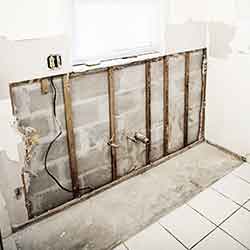The difference between asbestos removal vs. remediation
Many people are asking the question: what’s the difference between asbestos removal and remediation? Should you seek out asbestos removal services, or asbestos remediation, instead? It’s important to understand the difference because one makes sense, and one doesn’t!
What remediation means
Remediation would make sense if you were talking about mould in a home. Mould doesn’t appear on its own. It’s the direct result of excess moisture, which can be caused by rising damp, rain seepage, window frame gaps, door gaps, and more.
Mould spores settle on damp areas of your home and start to grow. So, unless you remediate (provide a remedy for), you are not going to be able to remove the mould permanently. It will keep coming back.
In the case of asbestos, it will not come back once you remove it. Thus, remediation is not a term you would use to describe asbestos removal. By removing the asbestos, you are getting to its source. When you choose a licensed asbestos removal business in NZ, you should also have no ongoing issues with it once it has been removed.
What removal means
You can use removal a little more freely – even when you’re talking about mould or asbestos. Asbestos removal is the process of getting rid of those building materials that contain it completely. Once a licensed removal expert carefully removes it from your property, it’s gone for good.
If your property contains damaged or exposed asbestos, then you would look for an asbestos removal company, not an asbestos remediation company.
When you need to remove asbestos
Now that we’ve established that it’s removal you’re after, we can get down to the nuts and bolts of when you need to call in the big guns to get the ball rolling. Many people question whether it’s safer to remove asbestos from a building or leave it where it is. The answer to that question can depend on the building materials’ condition and your future plans.
It’s not the asbestos’s existence that makes it dangerous. When it’s safely contained within sound building materials, it’s relatively harmless. It’s when it’s in the air that’s the problem. Asbestos particles can build up in your lungs and cause harmful conditions like mesothelioma and asbestosis.
Therefore, if the building materials you believe contain asbestos are not in their best condition, then the asbestos becomes a health risk. It’s at this point that you need to look for someone in NZ to remove asbestos.
You should also look at removing it if you plan on carrying out any renovations with or near building materials that might contain it. If you’re not sure, an asbestos removal (there’s that word again) expert can take a sample for laboratory testing to find out either way. Disturbance of building materials now and in the future should answer your question of whether and when you should remove asbestos.
What contains asbestos?
When people learned about the various benefits of asbestos in building materials, they put it in everything. For decades, it appeared in roofing, flooring, walls, insulation, heating and cooling units, and much, much more. If your house was built between 1930 and 1990, then there’s every reason to believe that at least something in it will have this mineral within.
Corrugated cement roofing, Fibrolite and Hardiplank cladding, Fibrolite eaves, textured ceilings and walls, wall linings, vinyl flooring, the list goes on. There is a myriad of different building materials and products that can be a cause for concern when the time comes to undertake house renovations. However, knowledge is power, so you can take all the necessary precautions before you get those alterations underway.
What if there is asbestos in my business or commercial building?
There is a lot of focus on asbestos in homes, but what about commercial buildings? They are not exempt from the same situation. But while a home doesn’t have to have an asbestos management plan, a business or commercial building does.
The plan should outline where the asbestos is, what type of asbestos it is, and how it will be managed (removed, monitored) in the future. This plan can be in digital or document form, but it must exist.
It should also contain the precise location, the procedure of work if it needs to be removed or sealed, and the timeline for this process. All workers involved in maintenance, the business owner, and the building owner should have a copy of your asbestos management plan.
Call the experts whenever asbestos is involved
DIY is in our DNA, or so the saying goes, but when asbestos is involved, it’s a different story. Whether you need to test for asbestos, remove it, or seal it, always bring in a licensed professional. You can then enjoy peace of mind that you’ve remedied the situation.


